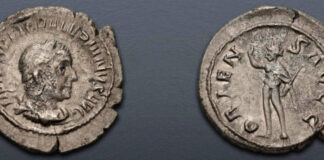
As part of the Achaemenid Empire, Caria in the fourth century BC was under the rule of a family of semi-independent satraps known as the Hekatomnids after the dynasty’s founder, Hekatomnos. Born in Mylasa, Hekatomnos was appointed satrap of Caria by Artaxerxes II after the fall of Tissaphernes in 392/1 BC and was later given control of Miletos in 386 BC. Interested in Hellenic culture (and possibly hedging his diplomatic bets), Hekatomnos sent his youngest son, Pixodaros, to Athens as part of a deputation; his older son, Maussolos, was bound by xenia, or guest friendship, with Agesilaus, king of Sparta. Hekatomnos died in 377/6 BC and was succeeded by Maussolos.
When Maussolus died in 353/2 BC, his sister-wife, Artemisia, succeeded him. Her rule, however, was short-lived, and in 351/0 BC power passed to Hidrieus, Artemisia’s brother and the second son of Hekatomnos. Hidrieus’ reign was also relatively short-lived, as he contracted a disease and died in 344/3 BC. Rule then passed to another sister, Ada.
A Coup With Serious Consequences
In 341/0 BC, Pixodarus, the youngest son of Hekatomnos, overthrew his sister, Ada, possibly aided by the external support of the Persian commander of Asia Minor, Mentor of Rhodes. This usurpation did little to endear the new satrap to Artaxerxes III, who had recently approved Ada’s appointment following the death of her husband, Hidrieus. Ada, nevertheless, continued to receive support from the countryside, and still held the city of Alinda. As a result, Caria was thrown into turmoil and hesitated to support Persia following the invasion of the Macedonians under Parmenion in 336 BC. This non-support of their nominal overlord was also compounded by the secret negotiations of alliance that Pixodaros had been conducting with the Macedonian king. In 337 BC, Pixodaros attempted a marriage between one of his daughters and the future Philip III Arridaios. Believing himself overlooked, Philip’s elder son, Alexander III, sent a private embassy to Halikarnassos, asking for the hand of the same princess. When word of this reached Philip II, he cancelled the Macedonian-Carian alliance. Pixodaros died of natural causes in 336/5 BC, and was succeeded by Orontobates, an otherwise unknown Persian, who apparently married the princess Pixodarus had attempted to betroth to Philip III. The fate of Orontobates is uncertain, but after Caria was conquered by Alexander III in 332 BC, the Macedonian king made diplomatic overtures to Ada, and reappointed her as satrap.
What Makes This Coin So Unique?
While the didrachms of Pixodaros are fairly common, his tetradrachms are rare, with only a handful known, even following the discovery of the Pixodarus Hoard, which added a mere 18 tetradrachms to the corpus. While many of these coins exhibit the same insipid style that became prevalent in the coins of Hidrieus, the present example displays a style of rare exuberance and vitality, both in the countenance of the facing head of Apollo on the obverse and in the stoic figure of Zeus Labraundos on the reverse. As this coin does not have the small E on the reverse, between the leg of Zeus and his scepter, which was apparently a carry-over from the coins of Hidreius, this suggests that these dies were engraved at a latter period during Pixodaros’ reign, and evidently by a new, highly talented artist. This later date is also suggested by the fact that no examples from these dies were present in the Pixodarus hoard, which is believed to have been deposited near the middle of his reign. The rarity of the tetradrachms also suggests that they were produced at a much smaller scale than the didrachms, and probably were struck for special occasions.
This coin is part of the Triton XXIV auction sale, which will be held on 19 and 20 January 2021. Online bidding is possible as of 15 December. If you would like to receive a print catalogue, contact CNG via email or phone at +1 (717) 390-9194.
The auction is available on the following websites: CNG Auctions, Sixbid and Numisbids.
If you would like to know more or are interested in a consignment, please contact Classical Numismatic Group, LLC, P.O. Box 479, Lancaster, PA 17608-0479, phone: +1 (717) 390-9194, fax: +1 (717) 390-9978, email: cng@cngcoins.com.
You can read a comprehensive auction preview here.





